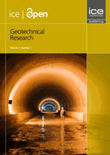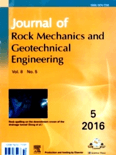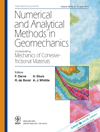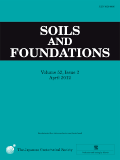
Rock and Soil Mechanics
Scope & Guideline
Elevating Standards in Rock and Soil Mechanics
Introduction
Aims and Scopes
- Geotechnical Engineering and Soil Mechanics:
Research related to the behavior of soil under different loading conditions, including consolidation, shear strength, and liquefaction phenomena. - Rock Mechanics and Structural Geology:
Studies that explore the mechanical behavior of rock masses, including fracture mechanics, rockburst phenomena, and the interaction between rock and engineering structures. - Numerical and Experimental Modeling:
Development and application of numerical methods (e.g., finite element, discrete element) and experimental techniques to model the behavior of soils and rocks under various conditions. - Environmental Geomechanics:
Research addressing the impacts of environmental factors such as moisture, temperature changes, and contamination on the mechanical properties of soil and rock. - Innovative Materials and Reinforcement Techniques:
Exploration of new materials and methods for soil and rock stabilization, including the use of geopolymers, microbial-induced calcite precipitation, and other innovative reinforcement techniques.
Trending and Emerging
- Coupled Hydro-Mechanical Behavior:
There is an increasing focus on understanding the coupled effects of hydraulic and mechanical processes in soils and rocks, particularly in the context of groundwater flow, seepage, and soil stability. - Advanced Numerical Simulations:
The use of sophisticated numerical methods, including machine learning and artificial intelligence, for predicting material behavior and optimizing designs is gaining traction in recent publications. - Sustainability and Environmental Impact:
Research addressing the sustainability of geotechnical practices, including the use of eco-friendly materials and remediation techniques for contaminated sites, is becoming more prominent. - Smart Materials and Technologies:
Investigations into smart materials and innovative technologies, such as geosynthetics and bioengineering methods for ground improvement, are increasingly featured. - Field Monitoring and Real-Time Analysis:
There is a growing trend towards the use of field monitoring techniques and real-time data analysis to inform the stability and performance of geotechnical structures.
Declining or Waning
- Traditional Soil Mechanics:
Research focusing solely on classical soil mechanics principles, such as simple consolidation tests and basic shear strength analysis, appears to be declining in favor of more integrated approaches that consider multi-factorial influences. - Static Analysis of Rock Structures:
The focus on static analysis methods for rock structures, without the incorporation of dynamic or time-dependent factors, has decreased as researchers seek to address the complexities of seismic and other dynamic loading conditions. - Basic Laboratory Testing Methods:
The prevalence of publications centered around conventional laboratory testing methods has diminished, as there is a shift towards more advanced techniques and technologies that provide greater insights into material behavior. - Single-Factor Studies:
Research that examines the effects of individual factors (e.g., only temperature or only moisture) without considering interactions with other environmental or mechanical factors has become less common.
Similar Journals

Geotechnical Research
Bridging theory and practice in earth sciences.Geotechnical Research is an esteemed scholarly journal published by EMERALD GROUP PUBLISHING LTD, dedicated to advancing the field of geotechnical engineering and earth sciences. With an impact factor reflective of its robust contributions, this open access journal has been providing unrestricted access to high-quality research since 2014, making it indispensable for researchers, professionals, and students alike. The journal, indexed under the ISSN 2052-6156, features rigorous peer-reviewed articles that encompass a wide range of topics within geotechnical engineering and engineering geology, achieving a notable placement in the Q2 category in both Earth and Planetary Sciences and Geotechnical Engineering as of 2023. With its Scopus ranks further affirming its significance—ranked #44 out of 159 in Earth and Planetary Sciences and #78 out of 229 in Geotechnical Engineering—Geotechnical Research stands as a vital resource for innovative solutions and advancements in this critical field, ensuring researchers access to essential insights that drive the discipline forward.

Geomechanics and Engineering
Exploring the Intersection of Geomechanics and EngineeringGeomechanics and Engineering is a premier journal published by TECHNO-PRESS that delivers high-quality research in the fields of civil and structural engineering, as well as geotechnical engineering and engineering geology. With an ISSN of 2005-307X and an E-ISSN of 2092-6219, this journal serves as a significant repository of innovative methodologies, case studies, and theoretical advancements. Located in South Korea, Geomechanics and Engineering is indexed in Scopus, where it boasts a commendable ranking of #100 out of 379 in Civil and Structural Engineering and #69 out of 229 in Geotechnical Engineering and Engineering Geology, reflecting its impact with substantial percentile rankings of 73rd and 70th, respectively. Over its converged years from 2009 to 2024, the journal aims to advance the understanding of geomechanical phenomena and their application in engineering, making it an essential read for researchers, professionals, and students committed to solving today's pressing engineering challenges.

Jordan Journal of Civil Engineering
Transforming Ideas into Engineering SolutionsThe Jordan Journal of Civil Engineering, ISSN 1993-0461 and E-ISSN 2225-157X, serves as a pivotal platform for research dissemination in the field of civil engineering. Published by Jordan University of Science & Technology, this journal has established itself as a vital resource since its inception in 2007 and continues to impact the academic community with its wide-ranging scope covering innovative practices and cutting-edge research in civil and structural engineering. Holding a respectable Q3 ranking in the 2023 category, with Scopus positioning it at rank #235 out of 379, the journal reflects growing recognition within its discipline. Although currently not an open-access publication, it provides essential insights that can benefit researchers, industry professionals, and students seeking to contribute to advancements in civil engineering through rigorous scholarly articles and studies up to 2024. Its commitment to high academic standards enhances the relevance and importance of its contributions to both local and global engineering practices.

Periodica Polytechnica-Civil Engineering
Championing Quality Research in Civil and Structural EngineeringPeriodica Polytechnica-Civil Engineering is a prestigious journal published by the Budapest University of Technology and Economics, dedicated to advancing the field of civil engineering through high-quality research and innovative practices. Established in 1972, the journal has transitioned through various phases of publication and now spans an expansive range of topics within civil and structural engineering, geotechnical engineering, and engineering geology. With an impact factor indicating its growing influence and a commendable placement in the Q3 quartile according to the latest 2023 metrics, it recognizes contributions that bridge theoretical advancements with practical applications. While currently not open access, the journal remains a vital resource for researchers, professionals, and students seeking to stay abreast of the latest developments in engineering design, construction techniques, and geotechnical innovations. The continuous publication of significant research after almost five decades underscores its commitment to disseminating knowledge crucial for the world’s infrastructure challenges, making it an essential reference point within the engineering community.

Journal of Rock Mechanics and Geotechnical Engineering
Pioneering Innovations in Rock Mechanics and Engineering GeologyThe Journal of Rock Mechanics and Geotechnical Engineering is a premier open-access publication dedicated to advancing the field of geotechnical engineering and engineering geology. Published by SCIENCE PRESS and based in China, this journal has been a vital resource for researchers and professionals since it transitioned to open access in 2013. With ISSN 1674-7755 and E-ISSN 2589-0417, it has established a global reputation, evidenced by its impressive Q1 ranking in the category of Geotechnical Engineering and Engineering Geology as well as a remarkable 8th rank out of 229 in Earth and Planetary Sciences, placing it in the 96th percentile according to Scopus. The journal aims to publish high-quality research that addresses contemporary challenges in the field, offering insightful perspectives and innovative solutions. Researchers, professionals, and students are encouraged to engage with the latest findings and methodologies published within its pages, which span from 2013 to 2024 and continue to pave the way for future advancements in geotechnical practices.

Soil Mechanics and Foundation Engineering
Exploring the Depths of Soil Behavior and DesignSoil Mechanics and Foundation Engineering, published by SPRINGER, is a prestigious academic journal dedicated to the dynamic fields of soil mechanics and foundation engineering. With a history spanning from 1964 to 2024, this journal serves as a vital platform for researchers, professionals, and students looking to advance their knowledge and explore innovative techniques in soil behavior, foundation design, and geotechnical engineering. Although the journal does not currently operate under an open access model, it remains essential for its contributions to key disciplines, notably in energy, geotechnical engineering, ocean engineering, soil science, and water science. Positioning itself in the third quartile of various categories in the 2023 rankings, it reflects a commitment to maintaining rigorous research standards despite its competitive environment. The unique intersection of its scope allows for multidisciplinary collaboration, making it an invaluable resource for those aiming to tackle the challenges in foundation systems and soil interactions in diverse engineering applications.

Geotechnical and Geological Engineering
Transforming Geological Insights into Engineering SolutionsGeotechnical and Geological Engineering, published by SPRINGER, is a premier journal dedicated to advancing the field of geotechnical and geological engineering. With a strong reputation demonstrated by a robust impact factor and notable Scopus rankings, the journal positions itself in the top quartile of categories such as Architecture and Geotechnical Engineering, making it an essential resource for researchers and practitioners alike. Established in 1991 and continuing through 2024, it provides a platform for original research that addresses the pivotal challenges in soil science, geology, and engineering geology. Although it does not offer open access, it remains accessible through institutional and personal subscriptions, ensuring that academic scholars, industry professionals, and students can engage with high-quality, peer-reviewed content. The journal's commitment to disseminating innovative findings and fostering interdisciplinary dialogue underscores its vital role in shaping future developments in engineering and environmental sustainability.

INTERNATIONAL JOURNAL FOR NUMERICAL AND ANALYTICAL METHODS IN GEOMECHANICS
Fostering Knowledge in Analytical GeomechanicsWelcome to the International Journal for Numerical and Analytical Methods in Geomechanics, a prestigious publication dedicated to advancing the fields of geotechnical engineering and computational mechanics. Published by Wiley in the United Kingdom, this journal has been at the forefront of research since its inception in 1977 and continues to provide a vital platform for disseminating innovative methodologies and analytical approaches through 2024. With an impressive impact factor reflecting its excellence, the journal consistently ranks in the Q1 category across multiple domains, including Computational Mechanics, Geotechnical Engineering, and Engineering Geology, making it a key resource for specialists seeking to keep informed on important developments in these areas. Although it does not offer open access, the journal remains highly regarded among researchers and professionals for its rigorous peer-review process and commitment to scientific integrity. As a vital contributor to the field, International Journal for Numerical and Analytical Methods in Geomechanics invites researchers, professionals, and students to explore its comprehensive studies and to advance knowledge at the intersection of numerical analysis and geomechanics.

Soils and Foundations
Exploring the depths of geotechnical engineering excellence.Soils and Foundations, an esteemed journal published by the Japanese Geotechnical Society, has established itself as a pivotal platform for innovative research in Civil and Structural Engineering and Geotechnical Engineering. With an impressive impact factor reflected in its Q1 quartile ratings for both disciplines, the journal provides critical insights that foster advancements in the understanding of soil behavior and foundation design. Since its transition to Open Access in 2020, Soils and Foundations has broadened its reach, ensuring accessible dissemination of knowledge to researchers, students, and professionals globally. With a rich history dating back to its inception in 1960, the journal continues to uphold a high standard of scholarly excellence, ranking within the top percentile in Scopus across geotechnical engineering fields. This commitment to quality and accessibility makes it an essential resource for anyone engaged in the vital areas of soil mechanics and foundation engineering.

ROCK MECHANICS AND ROCK ENGINEERING
Exploring Innovations in Geotechnical ScienceROCK MECHANICS AND ROCK ENGINEERING, published by SPRINGER WIEN, stands as a premier journal in the fields of civil and structural engineering, geology, and geotechnical engineering. Since its inception in 1983, this journal has evolved into a leading platform for the dissemination of high-quality research, underscored by its impressive Q1 quartile rankings in multiple relevant categories as of 2023. With a significant impact factor and a ranking of 8th out of 321 in Earth and Planetary Sciences (Geology), the journal attracts scholars and practitioners aiming to contribute to and stay abreast of advancements in rock mechanics and engineering practices. While it does not offer Open Access options, its comprehensive and rigorous peer-reviewed articles serve as essential resources for fostering knowledge and innovation in the sector. The commitment to exploring the interactions between geological materials and engineering applications makes this journal indispensable for researchers, professionals, and students dedicated to pushing the boundaries of these critical fields.